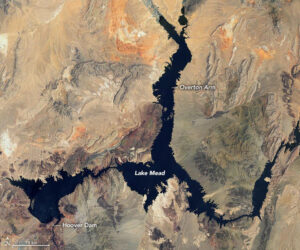AUGUST 23, 2023

Lake Mead in July 2000. – NASA Earth Observatory
Lake Mead water levels are at the highest point this year after Hurricane Hilary swept through the Southwest.
The lake stands 1,063.95 feet above mean sea level according to information collected by LakeLevels. This is over 20 feet higher than where the lake was on this day last year, almost four feet below where it was last year, and almost 20 feet under where the lake was in 2020.
A wet winter helped fill the reservoir on the Arizona and Nevada border on the Colorado River. At the beginning of the year, the lake was around 1044 feet above mean sea level, reaching 1050 feet in May. Prior to Hurricane Hilary making landfall, the lake measured 1063.49 feet above mean sea level.
Key reservoir filling doesn’t solve water issues
The Southwest has been experiencing a drought for 23 years, leading officials to cut a deal to promote water conservation in the region.
There have been concerns that the reservoirs are close to reaching “dead pool” status, where water levels are too low to continue the flow of water downstream.
“This buys a year,” longtime Colorado River expert Brad Udall told USA Today about the winter snowpack and precipitation. “It doesn’t remotely come close to solving the long-term problems.”
There was an attempt to improve parts of the Colorado River ecosystem earlier this year.
What’s the long-term outlook for the Colorado River?
Udall, who studies the river at Colorado State University’s Colorado Water Center, said this winter’s snow is likely an aberration, and that long-term trends show the West is getting drier due to climate change. He said the only real solution is to use less water.
Big snow years are happening half as often as they used to, while dry years are happening 2.5 times as often, he said.
“There’s two important components to get to a better place,” Udall shared. “The first is wishing for high flow years and the other is cutting demand. And we only control one of them.”










































































































